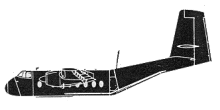Incident Overview

Description
On Friday, June 13th 1947, Amiot AAC.1 nø245 of Groupe de Transport I/64 ‘Barn’ of the Groupement des Moyens Militaires de Transport Arien of the Arme de l’Air (GT I/64, G.M.M.T.A.) was assigned for the regular ambulance flight transporting patients from Tan Son Nhut, Saigon, to the sanatorium at Dalat. Its crew consisted of pilot Sgt. Andr Dechelotte; flight engineer Repesse; navigator Andr Graveret; radio telegraphist Sgt. Casanova; and flight nurse Lucienne Just. It was carrying 17 passengers including women and children. The flight took place during the local monsoon season and was conducted under poor meteorological conditions, forcing the pilot to fly under IFR conditions. Its destination airport, Dalat, was located at an elevation of 962 m with surrounding mountains rising to 1500 m; the minimum safety altitude was 2000 m so in order to avoid terrain the flight maintained an altitude of 3000 m. With only wartime English air maps of the region at their disposal and no radio beacon available at Dalat, the flight was navigated using dead reckoning. About half an hour into an hour-long flight, the pilot started his descent through stratocumulus clouds. During his descent he suddenly saw terrain emerge from the clouds in front of him. Before he could pull up, the aircraft hit a mountain crest, causing the aircraft to break into two parts, with the front continuing beyond the crest, and the fuselage aft of the wings remaining on the other half. A post-crash fire partly consumed the aircraft’s wreckage. The crash was witnessed by locals who organised a rescue expedition. On arriving at the wreckage, they found ten occupants had been killed outright, eight had been injured to varying degrees either through the crash or the ensuing fire, and a further four had escaped injury. During the evacuation of the survivors, one further crew member succumbed to his injuries. Pilot Dechelotte, navigator Graverette and flight mechanic Repesse survived the accident but sustained injuries; flight nurse Just was killed on impact; and radio telegraphist Casanova died as a result of severe burns during the medevac. Nine out of seventeen passengers did not survive, including four children. The aircraft was found to have crashed 10 km off-course, either through prevailing winds pushing it off its planned flight course; a navigation error or a combination of both. As a result of the prevailing instrument flight conditions, this meant the pilot initiated his descent over mountainous terrain when he expected to be over level terrain. The aircraft impacted terrain at 1100m altitude.
Source of Information
https://books.google.be/books?id=ZlrT3EOUPZ0C&lpg=PA118&dq=%22lucienne%20just%22%201947&hl=nl&pg=PA117#v=onepage&q=%22lucienne%20just%22%201947&f=false, https://gallica.bnf.fr/ark:/12148/bpt6k47494156/f4.item.zoom, https://gallica.bnf.fr/ark:/12148/bpt6k4749416m/f3.item.zoom, http://nla.gov.au/nla.news-page1007108https://books.google.be/books?id=ZlrT3EOUPZ0C&lpg=PA118&dq=%22lucienne%20just%22%201947&hl=nl&pg=PA117#v=onepage&q=%22lucienne%20just%22%201947&f=false, https://gallica.bnf.fr/ark:/12148/bpt6k47494156/f4.item.zoom, https://gallica.bnf.fr/ark:/12148/bpt6k4749416m/f3.item.zoom, http://nla.gov.au/nla.news-page1007108Primary Cause
Inadequate navigation and weather conditions, specifically the pilot’s deviation from planned flight path due to mountainous terrain and poor visibility, combined with the pilot’s decision to initiate a descent through stratocumulus clouds, leading to a catastrophic crash.Inadequate navigation and weather conditions, specifically the pilot’s deviation from planned flight path due to mountainous terrain and poor visibility, combined with the pilot’s decision to initiate a descent through stratocumulus clouds, leading to a catastrophic crash.Share on:





